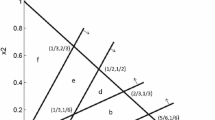Abstract
We examine the resource allocation problem of partitioning identical servers into two parallel pooling centers, and simultaneously assigning job types to pooling centers. Each job type has a distinct Poisson arrival rate and a distinct holding cost per unit time. Each pooling center becomes a queueing system with an exponential service time distribution. The goal is to minimize the total holding cost. The problem is shown to be polynomial if a job type can be divided between the pooling centers, and NP-hard if dividing job types is not possible. When there are two servers and jobs cannot be divided, we demonstrate that the two pooling center configuration is rarely optimal. A heuristic which checks the single pooling center has an upper bound on the relative error of 4/3. The heuristic is extended for the multiple server problem, where relative error is bounded above by the number of servers.
Similar content being viewed by others
References
Bain LJ, Engelhardt M. Introduction to probability and mathematical statistics. Boston: PWS-KENT Publishing Company; 1992.
Bell CE, Stidham S. Individual versus social optimization in the allocation of customers to alternative servers. Manag Sci 1983;29:831–9.
Calabrese JM. Optimal workload allocation in open networks of multiserver queues. Manag Sci 1992;38:1792–802.
Dallery Y, Stecke KE. On the optimal allocation of servers and workloads in closed queueing networks. Oper Res 1990;38:694–703.
Dyer ME, Proll LG. On the validity of marginal analysis for allocating servers in M/M/c queues (in notes). Manag Sci 1977;23:1019–22.
Frenk H, Labbe M, van Vliet M, Zhang S. Improved algorithms for machine allocation in manufacturing systems. Oper Res 1994;42:523–30.
Garey MR, Johnson DS. Computers and intractability: a guide to the theory of NP-completeness. San Francisco: Freeman; 1979.
Gilbert SM, Weng ZK. Incentive effects favor nonconsolidating queues in a service system: the principal-agent perspective. Manag Sci 1998;44:1662–9.
Green LV. A queueing system with general-use and limited-use servers. Oper Res 1985;33:168–82.
Green LV, Guha D. On the efficiency of imbalance in multi-facility multi-server service systems. Manag Sci 1995;41:179–87.
Hillier FS, Lieberman GJ. Introduction to operations research. New York: MacGraw–Hill; 2001.
Hillier FS, So KC. Toward characterizing the optimal allocation of storage space in production line systems with variable processing times (in notes). Manag Sci 1993;39:126–33.
Hillier FS, So KC. On the simultaneous optimization of server and work allocations in production line systems with variable processing times. Oper Res 1996;44:435–43.
Kimemia J, Gershwin SB. Flow optimization in flexible manufacturing systems. Int J Prod Res 1985;23(1):81–96.
Lee HL, Cohen MA. Multi-agent customer allocation in a stochastic service system. Manag Sci 1985;31:752–63.
Rolfe AJ. A note on marginal allocation in multiple-server service systems. Manag Sci 1971;17:656–8.
Roque DR. A note on “Queuing models with lane selection”. Oper Res 1980;28:419–20.
Rothkopf MH, Rech P. Perspectives on queues: combining queues is not always beneficial. Oper Res 1987;35:906–9.
Schwartz BL. Queuing models with lane selection: a new class of problems. Oper Res 1974;22:331–9.
Schwartz BL. Errata: queuing models with lane selection: a new class of problems. Oper Res 1976;24:386.
Shanthikumar JG, Yao DD. Optimal server allocation in a system of multi-server station. Manag Sci 1987;33:1173–80.
Shanthikumar JG, Yao DD. On server allocation in multiple center manufacturing systems. Oper Res 1988;36:333–42.
Smith DR, Whitt W. Resource sharing for efficiency in traffic systems. Bell Syst Tech J 1981;60:39–55.
Stecke KE, Solberg JJ. The optimality of unbalancing both workloads and machine group sizes in closed queueing networks of multiserver queues. Oper Res 1985;33:882–910.
Stidham S. On the optimality of single-server queuing system. Oper Res 1970;18:708–32.
Whitt W. Partitioning customers into service groups. Manag Sci 1999;45:1579–92.
Author information
Authors and Affiliations
Corresponding author
Rights and permissions
About this article
Cite this article
Hung, HC., Posner, M.E. Allocation of jobs and identical resources with two pooling centers. Queueing Syst 55, 179–194 (2007). https://doi.org/10.1007/s11134-007-9015-z
Received:
Revised:
Published:
Issue Date:
DOI: https://doi.org/10.1007/s11134-007-9015-z




